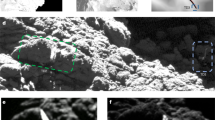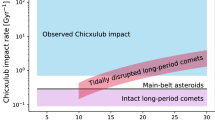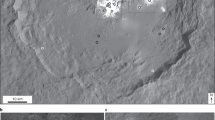Abstract
Outbursts occur commonly on comets1 with different frequencies and scales2,3. Despite multiple observations suggesting various triggering processes4,5, the driving mechanism of such outbursts is still poorly understood. Landslides have been invoked6 to explain some outbursts on comet 103P/Hartley 2, although the process required a pre-existing dust layer on the verge of failure. The Rosetta mission observed several outbursts from its target comet 67P/Churyumov–Gerasimenko, which were attributed to dust generated by the crumbling of materials from collapsing cliffs7,8. However, none of the aforementioned works included definitive evidence that landslides occur on comets. Amongst the many features observed by Rosetta on the nucleus of the comet, one peculiar fracture, 70 m long and 1 m wide, was identified on images obtained in September 2014 at the edge of a cliff named Aswan9. On 10 July 2015, the Rosetta Navigation Camera captured a large plume of dust that could be traced back to an area encompassing the Aswan escarpment7. Five days later, the OSIRIS camera observed a fresh, sharp and bright edge on the Aswan cliff. Here we report the first unambiguous link between an outburst and a cliff collapse on a comet. We establish a new dust-plume formation mechanism that does not necessarily require the breakup of pressurized crust or the presence of supervolatile material, as suggested by previous studies7. Moreover, the collapse revealed the fresh icy interior of the comet, which is characterized by an albedo >0.4, and provided the opportunity to study how the crumbling wall settled down to form a new talus.
This is a preview of subscription content, access via your institution
Access options
Access Nature and 54 other Nature Portfolio journals
Get Nature+, our best-value online-access subscription
$29.99 / 30 days
cancel any time
Subscribe to this journal
Receive 12 digital issues and online access to articles
$119.00 per year
only $9.92 per issue
Buy this article
- Purchase on Springer Link
- Instant access to full article PDF
Prices may be subject to local taxes which are calculated during checkout





Similar content being viewed by others
References
Hughes, D. W. in Comets in the Post-Halley Era Vol. 2 (eds Newburn, R.L. Jr, Neugebauer, M. & Rahe, J. ) 825−854 (Kluwer Academic, 1999).
Lin, Z. Y. et al. The outburst of comet 17P/Holmes. Astron. J. 138-2, 625–632 (2009).
Farnham, T. L. et al. Dust coma morphology in the Deep Impact images of comet 9P/Tempel 1. Icarus 187, 26–40 (2007).
Tubiana, C. et al. 67P/Churyumov–Gerasimenko: activity between March and June 2014 as observed from Rosetta/OSIRIS. Astron. Astrophys. 573, A62 (2015).
Knollenberg, J. et al. A mini outburst from the nightside of comet 67P/Churyumov–Gerasimenko observed by the OSIRIS camera on Rosetta. Astron. Astrophys. 596, A89 (2016).
Steckloff, J. K. et al. Rotationally induced surface slope-instabilities and the activation of CO2 activity on comet 103P/Hartley 2. Icarus 272, 60–69 (2016).
Vincent, J. B. et al. Summer fireworks on comet 67P. Mon. Not. R. Astron. Soc. 462, S184–S194 (2016).
Grün, E. et al. The 2016 Feb 19 outburst of comet 67P/CG: an ESA Rosetta multi-instrument study. Mon. Not. R. Astron. Soc. 462, S220–S234 (2016).
Pajola, M. et al. Aswan site on comet 67P/Churyumov–Gerasimenko: morphology, boulder evolution, and spectrophotometry. Astron. Astrophys. 592, A69 (2016).
Keller, H. U. et al. OSIRIS — the scientific camera system onboard Rosetta. Space Sci. Rev. 128, 433 (2007).
Preusker, F. et al. Shape model, reference system definition, and cartographic mapping standards for comet 67P/Churyumov–Gerasimenko: stereo-photogrammetric analysis of Rosetta/OSIRIS image data. Astron. Astrophys. 583, A33 (2015).
Fornasier, S. et al. Spectrophotometric properties of the nucleus of comet 67P/Churyumov–Gerasimenko from the OSIRIS instrument onboard the ROSETTA spacecraft. Astron. Astrophys. 583, A30 (2015).
Pommerol, A. et al. OSIRIS observations of meter-sized exposures of H2O ice at the surface of 67P/Churyumov–Gerasimenko and interpretation using laboratory experiments. Astron. Astrophys. 583, A25 (2015).
Barucci, M.A. et al. Detection of exposed H2O ice on the nucleus of comet 67P/Churyumov–Gerasimenko, as observed by Rosetta OSIRIS and VIRTIS instruments. Astron. Astrophys. 595, A102 (2016).
Fornasier, S. et al. Rosetta’s comet 67P/Churyumov–Gerasimenko sheds its dusty mantle to reveal its icy nature. Science 354, 1566–1570 (2016).
Delbo, M. et al. Thermal fatigue as the origin of regolith on small asteroids. Nature 508, 233–236 (2014).
Collins, B. D & Stock, G. M. Rockfall triggering by cyclic thermal stressing of exfoliation fractures. Nat. Geosci. 9, 395–401 (2016).
Molaro, J. L., Byrne, S. & Langer, S. A. Grain-scale thermoelastic stresses and spatiotemporal temperature gradients on airless bodies, implications for rock breakdown. J. Geophys. Res. 120, 255–277 (2015).
El-Maarry, M. R. et al. Fractures on comet 67P/Churyumov–Gerasimenko observed by Rosetta/OSIRIS. Geophys. Res. Lett. 42, 5170–5178 (2015).
Pajola, M. et al. Size-frequency distribution of boulders ≥7 m on comet 67P/Churyumov–Gerasimenko. Astron. Astrophys. 583, A37 (2015).
Ali-Lagoa, V., Delbo, M. & Libourel, G. Rapid temperature changes and the early activity on comet 67P/Churyumov–Gerasimenko. Astrophys. J. Lett. 810, L22 (2015).
Vincent, J. B. et al. Are fractured cliffs the source of cometary dust jets? Insights from OSIRIS/Rosetta at 67P/Churyumov–Gerasimenko. Astron. Astrophys. 587, A14 (2015).
Skorov, Y. V. et al. A model of short-lived outbursts on the 67P from fractured terrains. Astron. Astrophys. 593, A76 (2016).
Sierks, H. et al. On the nucleus structure and activity of comet 67P/Churyumov–Gerasimenko. Science 347, 1044 (2015).
Thomas, N . et al. The morphological diversity of comet 67P/Churyumov–Gerasimenko. Science 347, aaa0440 (2015).
Schloerb, F. P. et al. MIRO observations of subsurface temperatures of the nucleus of 67P/Churyumov–Gerasimenko. Astron. Astrophys. 583, A29 (2015).
Gulkis, S. et al. Subsurface properties and early activity of comet 67P/Churyumov–Gerasimenko. Science 347, 709 (2015).
Mottola, S. et al. The rotation state of 67P/Churyumov–Gerasimenko from approach observations with the OSIRIS cameras on Rosetta. Astron. Astrophys. 569, L2 (2015).
Mortimore, R. N. & Duperret, A. Coastal Chalk Cliff Instability (Geological Society of London, 2004).
Hapke, B. Bidirectional reflectance spectroscopy. 5. The coherent backscatter opposition effect and anisotropic scattering. Icarus 157, 523–534 (2002).
Hapke, B. The opposition effect of the Moon — the contribution of coherent backscatter. Science 260, 509–511 (1993).
Anderson, J. A . et al. Modernization of the Integrated Software for Imagers and Spectrometers. In Lunar and Planetary Science Conference 35 (eds Mackwell, S . & Stansbery, E .) 2039 (NASA, 2004).
Oklay, N. et al. Variegation of comet 67P/Churyumov–Gerasimenko in regions showing activity. Astron. Astrophys. 586, A80 (2016).
Weissmann, P. R. & Kieffer, H. H. An improved thermal model for cometary nuclei. J. Geophys. Res. 89, p. C358–C364 (1984).
Spencer, J. R. A rough-surface thermophysical model for airless planets. Icarus 83, 27–38 (1990).
Rozitis, B. & Green, S. F. Directional characteristics of thermal-infrared beaming from atmosphereless planetary surfaces — a new thermophysical model. Mon. Not. R. Astron. Soc. 415, 2042–2062 (2011).
Gundlach, B. & Blum, J. Outgassing of icy bodies in the Solar System. II: Heat transport in dry, porous surface dust layers. Icarus 219, 618–629 (2012).
Schloerb, F. P. et al. MIRO observations of subsurface temperatures of the nucleus of 67P/Churyumov-Gerasimenko. Astron. Astrophys. 583, A29 (2015).
Lowry, S. et al. The nucleus of comet 67P/Churyumov–Gerasimenko. A new shape model and thermophysical analysis. Astron. Astrophys. 548, A12 (2012).
Jorda, L. et al. The global shape, density and rotation of comet 67P/Churyumov–Gerasimenko from preperihelion Rosetta/OSIRIS observations. Icarus 277, 257–278 (2016).
Davidsson, B. J. R. & Rickman, H. Surface roughness and three-dimensional heat conduction in the thermophysical models. Icarus 243, 58–77 (2014).
Tan, L. Efficient algorithms for Crank–Nicolson-based finite-difference time-domain methods. IEEE Trans. Microw. Theory Tech. 56, 408–413 (2008).
Nyquist, H. Certain topics in telegraph transmission theory. Trans. Am. Inst. Elect. Eng. 47, 617 (1928).
Pajola, M. et al. Size–frequency distribution of boulders ≥10 m on comet 103P/Hartley 2. Astron. Astrophys. 585, A85 (2016).
Pajola, M. et al. The southern hemisphere of 67P/Churyumov–Gerasimenko: analysis of the preperihelion size–frequency distribution of boulders ≥7 m. Astron. Astrophys. 592, L2 (2016).
Pajola, M. et al. The Agilkia boulders/pebbles size–frequency distributions: OSIRIS and ROLIS joint observations of 67P surface. Mon. Not. R. Astron. Soc. 462, 242–252 (2016).
Michikami, T. et al. Size–frequency statistics of boulders on global surface of asteroid 25143 Itokawa. Earth Planets Space 60, 13–20 (2008).
Thomas, P. et al. Shoemaker crater as the source of most ejecta blocks on the asteroid 433 Eros. Nature 413, 394–396 (2001).
Bart, G. D. & Melosh, H. J. Distributions of boulders ejected from lunar craters. Icarus 209, 337–357 (2005).
Golombek, M. & Rapp, D. Size–frequency distributions of rocks on Mars and Earth analog sites: implications for future landed missions. J. Geophys. Res. 102, 4117–4129 (1997).
Acknowledgements
We thank M. Delbo for comments that led to substantial improvement of the paper. OSIRIS was built by a consortium of the Max-Planck-Institut für Sonnensystemforschung, in Göttingen, Germany, CISAS-University of Padova, Italy, the Laboratoire d’Astrophysique de Marseille, France, the Instituto de Astrofísica de Andalucia, CSIC, Granada, Spain, the Research and Scientific Support Department of the European Space Agency, Noordwijk, The Netherlands, the Instituto Nacional de Tecnica Aeroespacial, Madrid, Spain, the Universidad Politechnica de Madrid, Spain, the Department of Physics and Astronomy of Uppsala University, Sweden, and the Institut für Datentechnik und Kommunikationsnetze der Technischen Universität Braunschweig, Germany. The support of the national funding agencies of Germany (DLR), Italy (ASI), France (CNES), Spain (MEC), Sweden (SNSB) and the ESA Technical Directorate is gratefully acknowledged. We thank the ESA teams at ESAC, ESOC and ESTEC for their work in support of the Rosetta mission. M.P. was supported for this research by an appointment to the NASA Postdoctoral Program at the Ames Research Center administered by Universities Space Research Association (USRA) through a contract with NASA. M.F.A. acknowledges NASA funding through Jet Propulsion Laboratory contract no. 1267923 and from the Akademie der Wissenschaften zu Göttingen. W.-H.I acknowledges the Ministry of Science and Technology, Taiwan (grant no. NSC 102-2112-M-008) and Macau University of Science and Technology (grant no. FDCT 017/2014/A1).
Author information
Authors and Affiliations
Contributions
M.P. conceived, led and designed the study, analysed the cliff setting before and after the collapse, contributed to the spectrophotometric study, made the overall boulder size–frequency analysis and wrote the main text and Methods; S.H. carried out the thermophysical analysis and wrote part of the main text and Methods; J.B.V. performed the outburst analysis and wrote part of the main text; N.O. carried out the 6 August 2016 post-collapse spectrophotometric analysis, wrote part of the main text and Methods; F.S. and F.P. were responsible for the stereo-photoclinometric model and the 3D reconstruction of the pre- and post-collapse cases, and wrote part of the main text and Methods; S.M. contributed to the thermophysical analysis and made the illumination conditions video of 10 July 2015; G.N. contributed to designing the study and data interpretation; S.F carried out the 19 July 2015 spectrophotometric analysis, wrote part of the main text and Methods; S.L. contributed to the thermophysical analysis and wrote part of the main text; C.F. and P.H.H. contributed to the spectrophotometric study; C.G. and C.T. contributed to the data interpretation and made the Aswan observations possible; H.S., C.B., P.L., R.R., D.K. and H.R. are the lead scientists of the OSIRIS project. The other authors are all co-investigators who built and ran this instrument and made the observations possible, and associates and assistants who participated in the study.
Corresponding author
Ethics declarations
Competing interests
The authors declare no competing financial interests.
Supplementary information
Supplementary Information
Supplementary Figures 1–7, Supplementary Tables 1–2 and Supplementary Video 1 caption. (PDF 2107 kb)
Supplementary Video 1
Video representation of the illumination conditions at the Aswan cliff and plateau on 10 July 2015. (MP4 10311 kb)
Rights and permissions
About this article
Cite this article
Pajola, M., Höfner, S., Vincent, J. et al. The pristine interior of comet 67P revealed by the combined Aswan outburst and cliff collapse. Nat Astron 1, 0092 (2017). https://doi.org/10.1038/s41550-017-0092
Received:
Accepted:
Published:
DOI: https://doi.org/10.1038/s41550-017-0092
This article is cited by
-
Selected phenomena that affect the structure of the cometary landscape
Journal of Astrophysics and Astronomy (2021)
-
Cometary Nuclei—From Giotto to Rosetta
Space Science Reviews (2020)
-
Dust-to-Gas and Refractory-to-Ice Mass Ratios of Comet 67P/Churyumov-Gerasimenko from Rosetta Observations
Space Science Reviews (2020)
-
The influence of the cometary particles dynamics on the activity of comets
Journal of Astrophysics and Astronomy (2020)
-
The Philae lander reveals low-strength primitive ice inside cometary boulders
Nature (2020)



